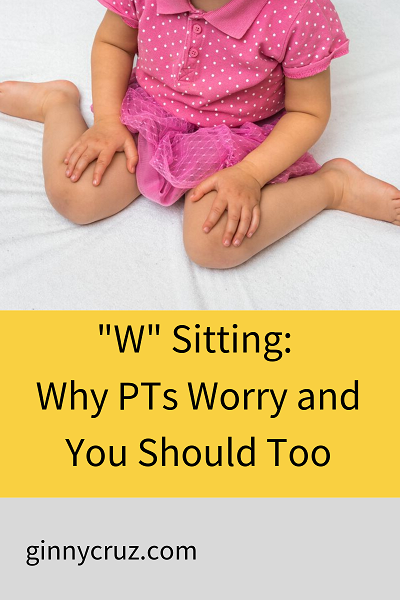“W” Sitting: Why PTs Worry and You Should Too
As babies learn to sit on the floor, they typically assume a ring sitting position. This is the position you think of when you picture a baby sitting on the floor. Later on, during the toddler stage, most children can sit on the floor in a crisscross position (used to be called Indian sitting). Some children, however, do not master these typical positions. Instead, they sit in a “W” sitting position.
The “W” sitting position (pictured above) is so named because the child’s legs look like they form the letter “W.” Although most of us cringe when we see a child’s legs in this position, it is quite comfortable for them.
If the position is comfortable and the child can play well in this position, you may be asking, “What’s the problem?” Here are a few reasons pediatric PTs worry about a child who sits in the “W” position:
- Sitting in the “W” position prevents the child from appropriately strengthening the hip and lower trunk muscles. In the typical ring or crisscross position, more muscles are strengthened and the child develops the ability to rotate and get in and out of sitting in a variety of ways. While a child’s sitting posture is quite stable in the “W” position, it is NOT stable AND mobile simultaneously which is what is most desirable.
- Chronically (most of the time) sitting in a “W” position increases the child’s risk of developing weak hip joints because the bones and muscles are not lining up correctly.
- Many children who chronically sit in a “W” position will develop knock knees and legs that are not straight. Knock knees are not desirable because this knee alignment often results in early-onset degenerative arthritis, deformity, and pain.
- Some children who prefer the “W” sit also develop flat feet that can be weak and painful.
Pediatric PTs want your child to be as strong and mobile as possible. They also do everything in their power to ward off pain and disability that may develop later in your child’s life. These are the reasons PT’s worry about the “W” sitting position.
Everyone wants a child to walk, run, jump, and climb and no one wants to see a child develop deformed hips, knees, or legs and pain. So, when you see your child chronically in the “W” sitting position, gently move them into a ring sit or side sitting position.
Please do not nag or expect your child to instantly correct this issue. After all, they like it. Sitting is easier for them in the “W” position. But just as with anything else in your child’s life, you will often need to help them change habits for their own good. Helping your child learn to sit in other positions will assist the development of strong hips and straight legs and, hopefully, prevent pain and deformity as they get older. Click here to see my suggestions on helping your child break the habit of W sitting.
Let me send you my FREE Tips for Concerned Moms.

